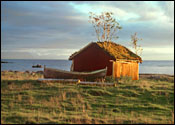|
Two Worlds United Programs in Norway for High School students
The
long, thin arm of Norway wraps around the top of Finland and
Sweden, opening its palm toward Denmark. Within its embrace are
20,917 kilometers (13,000 miles) of coast, the country's
lifeline. The waters of the seas and the fjords beat against
rocky shores or glide through green valleys, connecting many
communities that would otherwise be fairly isolated by the
rugged terrain and impassable mountains. This country is long
and very narrow—about 2,092 kilometers (1,300 miles) from top
to bottom. A traveler can cross it in eight hours by train from Oslo
to Bergen, even though the route goes through some of the most
rugged country ever to challenge a railway. In fact, the railway
does not extend all the way north (you're better off driving and
taking car ferries, or flying), nor can it service the coastal
towns efficiently. These towns are best accessed by coastal
steamer, the most reliable and beautiful way to tour the area.
And it is the coastal industries—fishing, shipping, and
offshore oil drilling—that have brought Norway its prosperity
and its prominence in international commerce.
Most students come to Norway with a checklist of things to see
and do. The fjords top the list, for nowhere else is there
anything quite like these deep, water-filled slices between
precipitous mountains. Next on most students' lists is the
midnight sun. Norway has more hours of daylight each year than
any other country in the world, and thousands of tourists trek
to the North Cape to see the red glow of the sun at midnight. Nonetheless, summer visitors to towns above the Arctic
Circle experience 24 hours of daylight, and the disorientation
caused by having to go to bed "by day."
Travelers journeying north are often surprised to find that the
cities above the Arctic Circle are rather lively, surrounded in
summer with green hills and sparkling fjords. The snow and gloom
are there as well—especially in Finnmark—and there is that
period, which can last from November to February, when there is
virtually no light beyond a pale, rosy glow for an hour or so.
For a truly arctic landscape, travelers can visit Svalbard/Spitzbergen,
the group of islands west of the mainland in the Arctic Ocean,
where winter iciness lingers most of the year. Here, only a few
inches of ground ever thaws, but even so, during the brief
summer, many varieties of plants thrive in the frigid soil. |

|
 |
TWO WORLDS UNITED
Admissions Dep't.
Tel: 1 (805) 581-9191
Fax: 1 (805) 581-6079
|